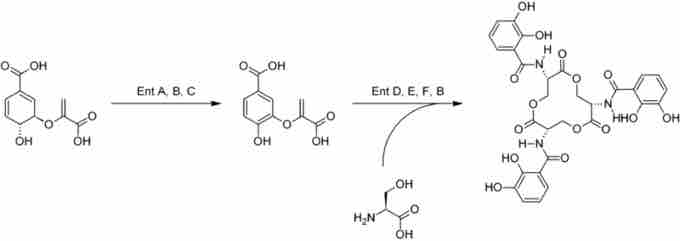Iron is essential for almost all living organisms as it is involved in a wide variety of important metabolic processes. However, iron is not always readily available; therefore, microorganisms use various iron uptake systems to secure sufficient supplies from their surroundings. There is considerable variation in the range of iron transporters and iron sources utilized by different microbial species. Pathogens, in particular, require efficient iron acquisition mechanisms to enable them to compete successfully for iron in the highly iron-restricted environment of the host's tissues and body fluids.
Siderophores are small, high-affinity iron chelating compounds secreted by microorganisms such as bacteria, fungi, and grasses. Siderophores are amongst the strongest soluble Fe3+ binding agents known. Iron is essential for almost all life, because of its vital role in processes like respiration and DNA synthesis. However, despite being one of the most abundant elements in the Earth's crust, the bioavailability of iron in many environments such as the soil or sea is limited by the very low solubility of the Fe3+ ion. This ion state is the predominant one of iron in aqueous, non-acidic, oxygenated environments, and accumulates in common mineral phases such as iron oxides and hydroxides (the minerals that are responsible for red and yellow soil colours). Hence, it cannot be readily utilized by organisms. Microbes release siderophores to scavenge iron from these mineral phases by formation of soluble Fe3+ complexes that can be taken up by active transport mechanisms. Many siderophores are nonribosomal peptides, although several are biosynthesised independently.
Siderophores are amongst the strongest binders to Fe3+ known, with enterobactin being one of the strongest of these. Because of this property, they have attracted interest from medical science in metal chelation therapy, with the siderophore desferrioxamine B gaining widespread use in treatments for iron poisoning and thalassemia.

Synthesis of enterobactin
Enterobactin (also known as Enterochelin) is a high affinity siderophore that acquires iron for microbial systems. It is primarily found in Gram-negative bacteria, such as Escherichia coli and Salmonella typhimurium.
Iron is tightly bound to proteins such as hemoglobin, transferrin, lactoferrin, and ferritin. There are great evolutionary pressures put on pathogenic bacteria to obtain this metal. For example, the anthrax pathogen Bacillus anthracis releases two siderophores, bacillibactin and petrobactin, to scavenge ferric iron from iron proteins. While bacillibactin has been shown to bind to the immune system protein siderocalin, petrobactin is assumed to evade the immune system and has been shown to be important for virulence in mice.
Besides siderophores, some pathogenic bacteria produce hemophores ( heme binding scavenging proteins) or have receptors that bind directly to iron/heme proteins. In eukaryotes, other strategies to enhance iron solubility and uptake are the acidification of the surrounding (e.g. used by plant roots) or the extracellular reduction of Fe3+ into the more soluble Fe2+ ions.
Siderophores usually form a stable, hexadentate, octahedral complex with Fe3+ preferentially compared to other naturally occurring abundant metal ions, although if there are less than six donor atoms water can also coordinate. The most effective siderophores are those that have three bidentate ligands per molecule, forming a hexadentate complex and causing a smaller entropic change than that caused by chelating a single ferric ion with separate ligands.
Siderophores are usually classified by the ligands used to chelate the ferric iron. The majors groups of siderophores include the catecholates (phenolates), hydroxamates and carboxylates (e.g. derivatives of citric acid). Citric acid can also act as a siderophore. The wide variety of siderophores may be due to evolutionary pressures placed on microbes to produce structurally different siderophores, which cannot be transported by other microbes' specific active transport systems, or in the case of pathogens deactivated by the host organism.